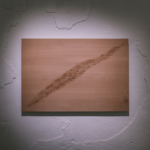
Half life
The Lieu Unique will be showing Stéfane Perraud and Aram Kebabdjian’s exhibition from the 3rd June to the 28th of August 2021. The show takes the viewer on a time-travel through nuclear landscapes. We met with the artists the day before the opening.
One is a visual artist, the other, a writer. Stéfane Perraud and Aram Kebabdjian have been collaborating for years, creating narrative machines that blur the boundaries between the potential reality and fiction of their artwork. The exhibition ‘Half-Life’ presents some of their research on irradiated landscapes and nuclear science. Narrative is woven through the installations and machines are augmented by literary fiction. Texts and images are able to dialogue but by avoiding being illustrative.
“What humanity has produced that is most durable”
Stéfane Perraud is leaning over the counter at the ‘Lieu Unique’, Aram Kebabdjian has just come back from smoking a cigarette. For the past five years, they have been exploring the puzzling nature of nuclear science, using their respective crafts: visual arts and writing. Half-life, curated by Patrick Gyger, is composed of three rooms: γ Archives, 160 MA and Blue Zone. Through the exhibition, one comes across a college of science, a giant descending ramp, a genetically modified forest and a nuclear package. “Each of these motifs, in their way, question the place and future of nuclear science on Earth and in our minds” says Aram Kebabdjian. Three installations that, without catastrophism, and sometimes through the use of the absurd, blend time frames, fiction and documentary, scientific and artistic, in order to grasp the chronological horizons opened up by nuclear science.
When questioned about the title, Stéfane Perraud responds immediately: “In nuclear physics, the notion of half-life is used to talk about radionuclide decay over time. Plutonium 239, synthesised in the making of bombs, has a half-life of 23 000 years. Uranium generated in power stations, 700 000 years old. It remains hazardous for five to six half-lives. Until this day, it is what humanity has produced that is most durable. There are no reasons why artists should refrain from using it.”
For these reasons, many art exhibitions have, in the past, tackled/worked on/approached/ the topic of nuclear technology. We’ve seen thematic exhibitions – scaremongering exhibitions generating fear and terror – activist exhibitions, anti-bomb, anti power plants and site-specific exhibitions- inside exclusion zones, power stations or tunnels. “Our approach is first and foremost determined by the singularity of both of us coming together” says Aram Kebabdjian. We collaborated for the first time five years ago. We created ‘Isotopia’, based on the periodic table of radioactive elements, and which became a boreal island, entirely made of radioactive materials. We set up a studio for Stéfane on it, drew the island’s story and created a guidebook for visitors. In order to creatively draw from nuclear science, it demands that one be in an intense state of vitality. Perhaps a touch of fantasy too. The reality that nuclear science uncovers is of course worrying, but nonetheless, remains human. “Half-life” explores what it might be like to be living in nuclear infused landscapes – where time and space aren’t quite the same anymore. Far from letting ourselves be petrified by fear or conceding to credulity, this is about telling stories, crossing landscapes….”
Photos – David Gallard







